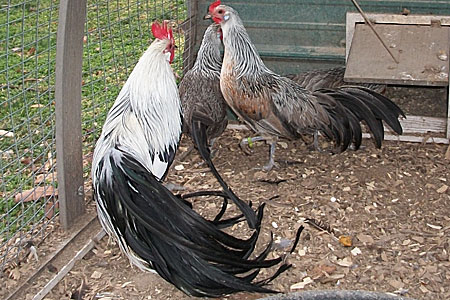
A chicken’s gender may be determined by a number of different methods. Which method works best depends on the bird’s age, breed and variety, and skill of the observer. Here are the four common ways to sex a chicken.
Vent Sexing
Vent sexing can be done soon after a chick hatches. Also called cloacal sexing, this method determines a chick’s gender by examining minor differences in the tiny cloaca just inside the vent. Accuracy requires a great deal of training, skill, and keen observation. Not to mention good lighting.
At hatcheries vent sexing is done by trained sexers. The accuracy rate of a really good vent sexer is 95 to 98 percent. However, some breeds are inherently difficult to sex, resulting in less accuracy. Bantams are rarely vent-sexed because they are so small and delicate they may be injured in the process.
Color Sexing
Color sexing also may be done at the time of hatch, although differences between the genders remain apparent for some time after the chicks hatch. This way to sex a chicken takes advantage of sex linked genes that control down and/or feather color.
Hybrid chicks that may be sexed according to color are called sex-links. In sex-links, such as Cinnamon Queen and Golden Comet, color differences remain into maturity. The gender accuracy for sex-links is 99 to 100 percent.
Color sexing within a single breed or variety is called autosexing. In some autosex breeds, such as Legbar, color differences persist into maturity. In such breeds, developed specifically as autosexing, accuracy is 100 percent.
In naturally autosexing breeds, such as the New Hampshire, female plumage color is quite similar to the male’s throughout life. Depending on the specific breed, the color sexing accuracy rate is 80 to 95 percent
Feather Sexing
Feather sexing may occur at hatch or up to three days after. This method involves recognizing growth rate differences in the primary feathers of hybrid chicks. Here the pullets’ wing feathers are longer at the time of hatch.
This method works only with hybrid chicks developed by crossing a slow feathering female, such as a Cochin, with a fast feathering male, such as a Marans. The technique is typically employed by the white Cornish-cross broiler industry, which crosses a slow feathering breeding line with a fast feathering breeding line.
Sexing by this method has an accuracy rate of about 99 percent. But it works only during the first three days post hatch. After that the length of the cockerels’ wing feathers catch up with the length of the pullets’ wing feathers.
Wait and See
The surest way for most people to sex a chicken is the wait and see method. This technique involves observing differences in the physical features and behavior patterns between males and females. These features start becoming apparent at three weeks of age, or sometimes later, depending on the breed.
As cockerels grow, they develop combs and wattles that are larger and more brightly colored than those of the pullets. Breeds with large single combs usually develop early and are more obvious. At about the same time the roosters start crowing.
But some individuals develop later than others, especially in a flock with multiple roosters. And some breeds, especially Silkies, are difficult to differentiate until they are nearly mature.
The males of most breeds also develop longer or fuller tail feathers than the females. And the males of most breeds have pointed neck and saddle feathers, in contrast to the females’ rounded neck and saddle feathers.
An exception is the Sebright bantam, which is hen feathered — meaning the males and females have nearly identical plumage, even into maturity. So with Sebrights, the only foolproof sexing method is to wait for the males to develop their larger combs and wattles or start crowing.
And that’s today’s news from the Cackle Coop.
Gail Damerow has written numerous books about poultry, including The Chicken Encyclopedia.

